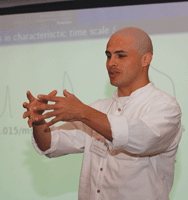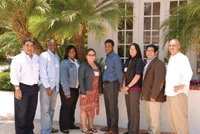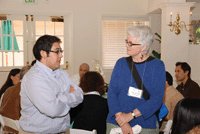11th SIAM Diversity Day Held in San Diego, July 2008
December 21, 2008

July was a good month for Jimena Davis, one of seven graduate students who spoke at Diversity Day, held in San Diego on July 9, during the 2008 SIAM Annual Meeting. Davis's talk---on the population dynamics of mosquitofish, a mosquito-control agent used as an alternative to pesticides in many rice-growing countries---was based on her dissertation, "Uncertainty Quantification in the Estimation of Probability Distributions on Parameters in Size-Structured Population Models," which she completed under the supervision of H.T. Banks at North Carolina State University. She received her PhD in July and is now a postdoc in the National Center for Computational Toxicology at the U.S. Environmental Protection Agency.
The Diversity Day audience heard about the mosquitofish population model on which Davis worked at NC State, developing computationally efficient approximation methods for estimating the distribution of population growth rates. Davis, whose graduate study was supported by a Computational Science Graduate Fellowship from the Department of Energy, worked during the summers at Sandia National Laboratories---on the biochemistry of bacteria. Her experiences as a DOE Computational Science Graduate Fellow are described in the annual report of the program (DEIXIS, 2007�08, available from http://www2.krellinst.org/csgf/deixis/).
Assessing Diversity Day as a valuable "opportunity to share my research with others as well as meet other minority graduate students and hear about their research," Davis encourages others to get involved in this "truly valuable experience for minority mathematicians."

In 1997, as a beginning graduate student at the National Autonomous University of Mexico, Marco Herrera went to the University of Arizona as part of a graduate exchange program between the universities. Not long afterward, he enrolled in a PhD program at Arizona to study dynamical systems, specifically the dynamics of molecular flux across membranes.
Realizing early on that his "fascination with dynamical systems extended beyond the models to the systems themselves," he set out to acquire the necessary background in the biological sciences. In parallel, he continued to study mathematics.
In July 2008, Herrera gave a talk at Diversity Day in San Diego titled "A Simple, Generic, and Physiologically Significant Model for the Pacemaker Dynamics of Cardiac Cells." A month later, he successfully defended his dissertation for a PhD in physiology; his re-search was on the relation between nearly coincident spiking and common excitatory synaptic input in motor neurons. He expects to receive a second PhD, in mathematics, in the spring of 2009.
Herrera's plans for the near future include postdoctoral work at the Mathematical, Computational and Modeling Sciences Center at Arizona State University. Not surprisingly, the career he envisions will be centered on "research combining mathematics and physiology."
"I think it is very important for graduate students to talk at meetings like the SIAM conference held last summer," Herrera says. "It helps the students realize how their work fits in a bigger picture concerning mathematics and science."

Diversity Day organizer Ricardo Cortez of Tulane University (far left), shown in San Diego with the day's seven graduate student speakers: Bassidy Dembele, Jimena Davis, Silvia Jim�nez Bola�os, James Gatewood, Rosalyn Rael, Luis de la Torre, and Marco Herrera.
Silvia Jim�nez Bola�os, now finishing a PhD at Louisiana State University, titled her Diversity Day talk "Corrector Theory for the Homogenization of Nonlinear Composite Materials." The workshop "gave me a great opportunity to present my work at a national meeting, with the advantage that it happens in a supportive and friendly environment," she says. "It was my first talk at a conference, and I cannot imagine how it could have been a better experience."
Under the supervision of Robert Lipton, Jim�nez is studying the behavior of local fields in heterogeneous media, working to develop new multiscale tools to bound the singularity strength inside microstructured media in terms of the macroscopic applied fields. Future plans, along with application for postdoctoral positions, include generalization of her research results to the case of random materials and the search for novel properties that can be derived from nonlinear composite materials.
Students, especially from underrepresented minorities, should take advantage of opportunities like Diversity Day, she says. "Many students are unaware of the importance of getting involved in these activities. This workshop was a great place to find mentoring and networking that will help me in my future career."
Now an assistant professor in the Department of Mathematics and Computer Science at Grambling State University, in Grambling, Louisiana, Bassidy Dembele had just received his PhD when he spoke at Diversity Day. His talk, "Malaria Model in Periodic Environments," was based on his dissertation research, as is a paper that is slated to appear in the Journal of Biological Dynamics. Dembele is now working on some of the "many open questions that can be generated from my work."
"It is always a good thing to attend SIAM meetings," he says, citing the friendly atmosphere and the rewarding collaborations that often ensue.
University of Arizona graduate student Rosalyn Rael applies evolutionary game theory to systems of interacting organisms; she described her research at Diversity Day in a talk titled "Emergence of a Coexistence from Competition in an Evolutionary Game." She is also studying "how evolution can affect the outcomes of other systems, such as predator�prey systems." The goal, she says, is "to explore how evolution can change the outcomes of various ecosystem interactions."
Rael expects to receive her PhD in May 2009 and is now looking into postdoctoral fellowships. She found the Diversity Day program "a wonderful opportunity to present my research at a major conference. I was also able to develop some very valuable connections with people at the lunch"---including SIAM president Cleve Moler.
Like other Diversity Day participants, Rael considers the SACNAS (Society for Advancement of Chicanos and Native Americans in Science) conference, held this year in Salt Lake City, October 9�12, a valuable experience for minority students; her own participation dates back to her undergraduate years. She also credits two other programs---the Mathematical and Theoretical Biology Institute, then at Cornell, and the Los Alamos National Laboratory summer program for students---for paving her way to graduate school.

Luis de la Torre, currently a beginning graduate student at Northwestern University, was featured in SIAM News as a 2007 participant in MSRI-UP, a summer research program for undergraduates. Shown here in San Diego with MSRI associate director Kathleen O'Hara, he was one of the seven graduate student speakers at Diversity Day; his talk was titled "Detecting Network Vulnerabilities Through Discrete Graph Methods."

Lunchtime conversation with SIAM board member Petter Bj�rstad was part of the Diversity Day experience for (standing, left to right) Donavion Huskey (Harvey Mudd College), Carmen Smith (Spelman College), and James Gatewood (Rensselaer Polytechnic Institute), and (seated) Gilbert Ymbert and Russell Carden, both of Rice University. Gatewood, one of the graduate student speakers, gave a talk titled "Traffic Flow Model of the Internet."

